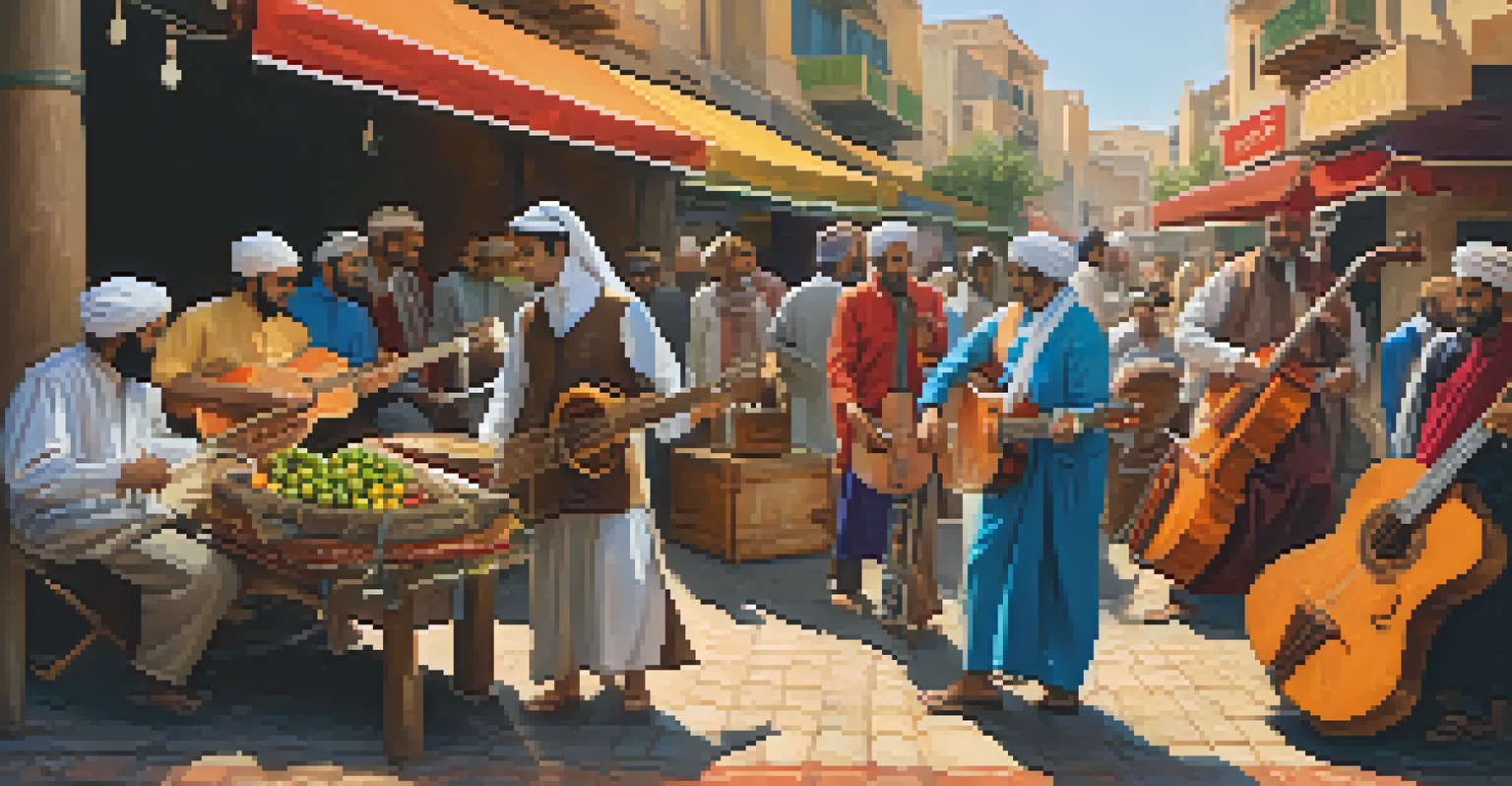Exploring the Impact of Middle Eastern Music on Guitar

Understanding the Roots of Middle Eastern Music
Middle Eastern music is rich in history and culture, often characterized by its unique scales, known as maqamat. These scales create a distinctive sound that sets Middle Eastern music apart from Western traditions. This cultural backdrop is essential for understanding how these musical elements influence guitar playing today.
Music is the universal language of mankind.
Often, traditional Middle Eastern instruments like the oud and qanun have been at the forefront, but the guitar has started to carve out its place in this landscape. Musicians are increasingly blending these ancient sounds with modern styles, creating a captivating fusion. This fusion not only enriches the music but also invites guitarists to explore new techniques and sounds.
By embracing these diverse influences, guitarists can expand their musical vocabulary, allowing for more creativity and expression in their playing. Understanding these roots is the first step in appreciating the intricate relationship between Middle Eastern music and the guitar.
Exploring Maqamat and Their Application on Guitar
Maqamat, the scales used in Middle Eastern music, offer a fascinating departure from the Western major and minor scales. Each maqam brings its own mood and emotion, providing guitarists with a palette of colors to choose from. For example, the Hijaz maqam evokes a sense of longing, which can deeply resonate in a guitar solo.

Guitarists who delve into these scales often find themselves playing in ways that feel more fluid and expressive. By incorporating these unique intervals and ornamentation techniques, they can create melodies that are both intricate and emotive. This exploration encourages musicians to step outside their comfort zones, fostering growth in their playing style.
Maqamat Enhance Guitar Creativity
Exploring maqamat allows guitarists to expand their musical vocabulary and express emotions more fluidly.
Learning to play within the framework of maqamat not only enhances technical skills but also deepens the understanding of music as a universal language. This connection can lead to innovative musical collaborations that bridge cultural divides.
Techniques Borrowed from Traditional Instruments
Many guitarists have begun to adopt techniques from traditional Middle Eastern instruments, adapting them to the guitar. Techniques like fingerpicking, rapid tremolos, and slides mimic the expressive qualities of the oud and other stringed instruments. This cross-pollination of styles results in a dynamic and captivating sound.
The beauty of music is that it transcends cultural boundaries and connects us all.
For instance, the use of microtones—notes that fall between the standard pitches of Western music—can be introduced on the guitar, requiring a special approach to tuning and playing. This allows guitarists to achieve a sound that’s authentic to Middle Eastern music while still retaining the guitar's unique character.
As musicians experiment with these techniques, they often find new ways to express their individuality. This melding of styles not only creates rich musical textures but also celebrates the beauty of cultural exchange.
Influential Guitarists in Middle Eastern Music
Several guitarists have played pivotal roles in integrating Middle Eastern music into their work, showcasing the instrument's versatility. Artists like Omar Faruk Tekbilek and Ravi Shankar have inspired countless musicians by blending traditional sounds with contemporary styles. Their innovative approaches have opened doors for guitarists eager to explore this genre.
These musicians often incorporate traditional rhythms and scales into their compositions, demonstrating how the guitar can effectively convey the essence of Middle Eastern music. Their work not only showcases technical skill but also emphasizes the emotional depth that can be achieved through this fusion.
Cultural Techniques Enrich Playing
Adopting techniques from traditional Middle Eastern instruments can create a dynamic sound and celebrate cultural exchange.
By studying these influential figures, aspiring guitarists can gain insights into how to navigate the complexities of Middle Eastern music. Their contributions serve as a blueprint for others looking to make their mark in this vibrant musical landscape.
Fusion Genres and the Global Appeal of Guitar
The fusion of Middle Eastern music with other genres has led to the creation of captivating new styles, such as world music and fusion jazz. This blending not only showcases the guitar's adaptability but also its ability to resonate with diverse audiences. Guitarists can experiment with various genres while infusing elements of Middle Eastern music into their compositions.
For example, artists like Anouar Brahem have incorporated jazz elements into traditional Middle Eastern frameworks, creating a sound that is both innovative and deeply rooted in cultural traditions. This fusion highlights how the guitar can serve as a bridge between different musical worlds, inviting listeners on a global journey.
As the popularity of these fusion genres grows, more guitarists are inspired to explore the rich tapestry of sounds available to them. This trend encourages a deeper appreciation for cultural diversity and the artistic expressions that emerge from it.
Learning Resources for Aspiring Guitarists
For guitarists interested in exploring Middle Eastern music, there are numerous resources available to aid their journey. Online courses, tutorials, and instructional videos provide valuable insights into playing techniques, scales, and rhythms unique to this genre. These resources can help guitarists develop a strong foundational knowledge before diving deeper into their practice.
Books and instructional materials on Middle Eastern music theory are also beneficial, offering explanations of maqamat and traditional playing styles. Engaging with these materials can deepen one's understanding and appreciation of the music, ultimately enhancing their playing experience.
Fusion Genres Broaden Guitar Appeal
The integration of Middle Eastern music with other genres showcases the guitar's versatility and resonates with diverse audiences.
Moreover, joining online communities and forums dedicated to Middle Eastern guitar can provide networking opportunities and support. By connecting with other musicians, aspiring guitarists can share their experiences, ask questions, and gain valuable feedback.
The Future of Guitar in Middle Eastern Music
As the world becomes more interconnected, the future of guitar in Middle Eastern music looks bright. The continuous blending of cultures and musical styles creates a fertile ground for innovation. Guitarists are likely to push boundaries even further, introducing new techniques and collaborative projects that challenge traditional norms.
Emerging artists are already experimenting with technology, incorporating electronic elements into their music. This integration not only enhances the sound but also introduces a modern twist, making Middle Eastern music more accessible to younger audiences. The guitar, as a versatile instrument, will undoubtedly play a key role in this evolution.

Ultimately, the fusion of Middle Eastern music and guitar will continue to thrive, reflecting the dynamic nature of cultural exchange. As musicians from all backgrounds embrace this rich tradition, the possibilities for creativity and expression are limitless.